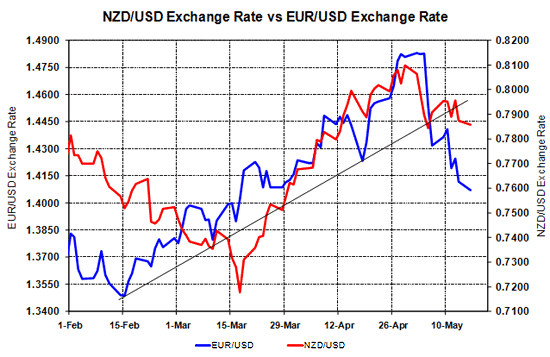

By Roger J Kerr
Going back a few weeks we had the US dollar being smashed in the FX markets for continuing loose monetary policy and the fiscal policy/debt ceiling of the US Government running into political roadblocks.
The USD is now recovering in the markets due to a correction in commodity prices and the European sovereign debt situation deteriorating further.
Super loose monetary policy and a weak fiscal position is precisely what we have in New Zealand right now, so why is the NZD not being slammed down?
The answer of course is that growth/commodity/Asian-linked (AUD and NZD) currencies have been the darling of global investment markets and Government bond yields above 5.00% outweighs economic policy concerns for foreign investors.
The local currency markets are arguably still at a 50/50 probability on a NZ sovereign credit rating downgrade post this week’s budget.
As more detail on the budget is filtered out beforehand, I am growing more comfortable that Standard & Poor’s will not downgrade NZ.
The forecast fiscal deficits and return to budget surplus by 2015/2016 are heavily dependent upon GDP growth meeting the Treasury GDP growth forecasts.
My view is that 2% GDP growth this year and 4% GDP growth next year are credible forecasts given the boost to the NZ economy that comes from the super high agriculture export commodity prices.
The balance comes from whether households spend or save.
Improving dairy farmer balance sheets from rising land values and income increases elsewhere auger well for the recent uptick in consumer spending (post earthquake) to continue for the rest of this year and into next.
Government expenditure savings also come from the debt interest cost on Government bonds being closer to 5% than the 6% the Treasury would have been forecasting earlier. The budget will have lots of small tinkering adjustments that overall add up to enough Government expenditure control that satisfies Standard & Poors.
The NZD/USD exchange rate may therefore not suffer a two or three cent sell-off on a credit rating downgrade, however it still has some catching up to do on the weaker Euro against the USD – which has moved sharply below its support line at $1.4450 (now trading at $1.4060)

--------------------
* Roger J Kerr runs Asia Pacific Risk Management. He specialises in fixed interest securities and is a commentator on economics and markets. More commentary and useful information on fixed interest investing can be found at rogeradvice.com
No chart with that title exists.

We welcome your comments below. If you are not already registered, please register to comment
Remember we welcome robust, respectful and insightful debate. We don't welcome abusive or defamatory comments and will de-register those repeatedly making such comments. Our current comment policy is here.